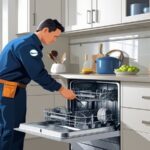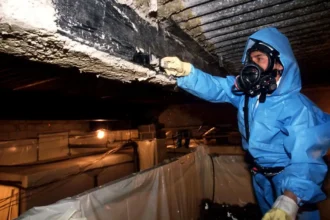Cincinnati homeowners face distinct seasonal challenges that put significant demands on their heating and cooling systems throughout the year. From humid summers to freezing winters, HVAC systems work year-round to maintain comfortable indoor temperatures. When these systems fail or operate inefficiently, finding qualified repair technicians becomes a priority.
Professional HVAC repair technicians in Cincinnati typically charge between $146 and $1,892 for repairs, with costs varying based on the complexity of the issue and the type of system involved. The area has numerous established service providers, including both family-owned businesses and larger companies with extensive service histories. Many of these technicians hold proper certifications and offer prompt response times for urgent repairs.
Selecting the right HVAC repair technician involves understanding what separates competent service providers from exceptional ones. This guide examines the essential qualifications homeowners should look for and outlines the most common repair services needed in Cincinnati homes. Understanding these factors helps homeowners make informed decisions when their heating or cooling systems require professional attention.
Key Qualities of Top HVAC Repair Technicians in Cincinnati
The best HVAC technicians in Cincinnati combine technical proficiency with professional service standards. These professionals bring certification credentials, hands-on experience with diverse systems, and a commitment to transparent business practices.
Expertise in Heating and Cooling Systems
Technical expertise forms the foundation of quality HVAC services. Skilled technicians possess deep knowledge of both traditional and modern heating and cooling equipment, including furnaces, heat pumps, air conditioners, and ductless systems.
This expertise allows them to diagnose problems accurately across different brands and models. They understand the complexities of refrigerant handling, electrical components, and mechanical systems that keep homes comfortable year-round.
Experience with Cincinnati’s climate patterns matters significantly. Technicians who regularly service local homes understand the specific demands placed on systems during humid summers and cold winters. They recognize common regional issues like ice buildup on outdoor units or furnace strain during temperature drops.
Top repair specialists stay current with evolving technology and energy efficiency standards. They receive ongoing training on smart thermostats, variable-speed systems, and high-efficiency equipment that homeowners increasingly install.
Certification, Licensing, and Local Knowledge
Proper credentials verify a technician’s competency and legal standing. Licensed HVAC professionals in Ohio meet state requirements for training and examination. EPA certification for refrigerant handling is mandatory for anyone working with cooling systems.
Many leading technicians hold additional certifications from industry organizations or manufacturers. These credentials demonstrate commitment to professional development and specialized knowledge in specific equipment types.
Local experience provides practical advantages beyond basic qualifications. Technicians familiar with Cincinnati’s building codes, permit requirements, and common home construction styles work more efficiently. They understand which system configurations perform best in local conditions.
Background checks and insurance coverage protect homeowners during service visits. Established companies typically screen their technicians and maintain liability insurance and workers’ compensation policies.
Prompt Service and Transparent Pricing
Reliable technicians respond quickly when heating and cooling systems fail. Fast response times matter especially during extreme weather when comfort and safety are at stake. Many top-rated Cincinnati providers offer same-day or next-day service appointments.
Clear communication about pricing prevents surprises. Professional technicians provide detailed estimates before starting work and explain what repairs involve. They itemize parts and labor costs so homeowners understand exactly what they pay for.
Transparent pricing typically includes:
- Written estimates before work begins
- Explanation of repair options and costs
- No hidden fees or surprise charges
- Warranty information on parts and labor
Technicians who share their knowledge help homeowners make informed decisions. They explain system problems in straightforward terms and present repair versus replacement options with honest assessments of each choice’s value.
Common HVAC Repair Services for Cincinnati Homes
Cincinnati homeowners face distinct climate challenges that require reliable heating and cooling systems throughout the year. Professional technicians address issues ranging from refrigerant leaks in air conditioners to malfunctioning heat pump components and outdated thermostat systems.
Air Conditioning Repair and Diagnostics
Air conditioning repair addresses mechanical failures, refrigerant issues, and electrical problems that prevent systems from cooling effectively. Technicians diagnose problems by checking refrigerant levels, testing compressor function, and inspecting electrical connections. Low refrigerant often indicates leaks that require sealing before the system can be recharged.
Common repairs include replacing failed capacitors, cleaning or replacing clogged air filters, and repairing damaged condenser coils. Frozen evaporator coils typically result from restricted airflow or low refrigerant levels. Technicians use specialized tools to measure temperature differentials and identify whether the system achieves proper cooling cycles.
Strange noises often signal worn bearings, loose fan blades, or failing motors. Circuit board malfunctions can prevent the system from starting or cause it to cycle improperly. Professional diagnostics identify the root cause rather than just addressing symptoms.
Heat Pump Maintenance and Repairs
Heat pumps provide both heating and cooling by transferring heat rather than generating it through combustion. These systems require specific maintenance to handle the reversing valve that switches between heating and cooling modes. Technicians check defrost controls during winter months to prevent ice buildup on outdoor coils.
Common heat pump issues include:
- Refrigerant leaks reducing heating or cooling capacity
- Faulty reversing valves preventing mode changes
- Frozen outdoor coils during cold weather
- Worn compressor components causing efficiency loss
Heat pumps work harder in extreme temperatures, making regular maintenance necessary for Cincinnati’s variable climate. Technicians measure amp draw on the compressor and check for proper airflow across indoor and outdoor coils. Backup heating elements may need testing to ensure they activate when outdoor temperatures drop below the heat pump’s efficient operating range.
Ductless Mini-Split Solutions
Ductless mini-splits offer zone-based climate control without requiring extensive ductwork. Each indoor unit connects to an outdoor compressor through refrigerant lines and electrical wiring. Technicians service these systems by cleaning filters, checking drain lines, and testing individual zone controls.
Common repairs involve addressing refrigerant leaks at connection points, replacing faulty fan motors, and fixing drainage problems that cause water leakage. The remote controls and wireless communication between units can malfunction and require reprogramming or replacement.
Installation issues often cause problems years later if refrigerant lines weren’t properly insulated or if mounting brackets become loose. Technicians verify each indoor unit maintains proper temperature control and responds correctly to thermostat commands.
Thermostat Troubleshooting and Upgrades
Thermostats control when heating and cooling systems activate based on temperature readings and programmed settings. Faulty thermostats cause short cycling, temperature inconsistencies, or complete system failure. Technicians test thermostat accuracy by comparing readings to calibrated thermometers and checking wire connections for loose or corroded contacts.
Older mechanical thermostats use bimetallic strips that can lose calibration over time. Digital thermostats require battery replacement and occasionally need software updates. Compatibility issues arise when homeowners attempt to install smart thermostats without proper wiring configurations.
Upgrade benefits include:
Feature | Benefit |
Programmable schedules | Reduced energy costs through automated setbacks |
Remote access | Temperature control from smartphones |
Learning algorithms | Automatic adjustment to household patterns |
Multi-zone control | Independent temperature settings per room |
Technicians ensure new thermostats communicate properly with HVAC equipment and configure settings for optimal efficiency. They verify that C-wire power connections exist or install adapter kits when necessary for smart thermostat operation.
















